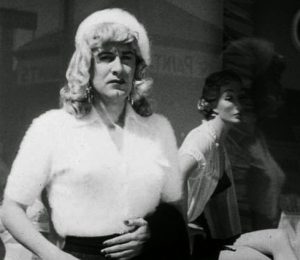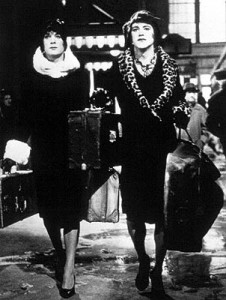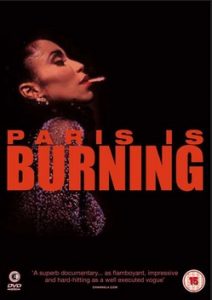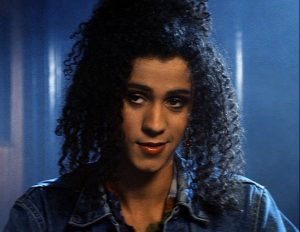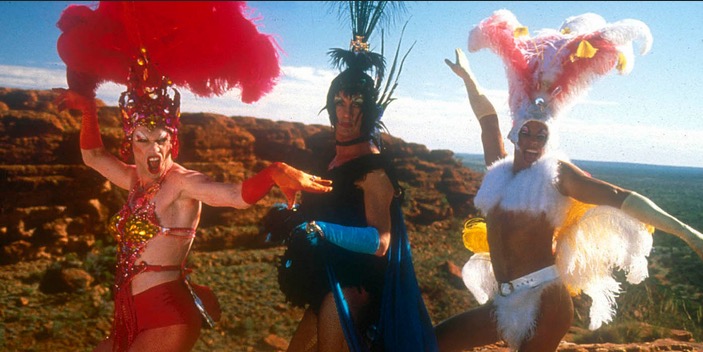Cinema of Ambiguity: Transgender Imagery in the 1990s
The early years of the 1990s witnessed an unexpected change in the status of transgender cinema. Formerly relegated to the position of B-grade oddities (Ed Wood’s Glen or Glenda being a particularly egregious example), the genre had moved perceptibly towards the mainstream by the middle of the decade. The phenomenon was characterized by a considerable degree of diversity in both form and content. Certainly, the images presented in films such as Priscilla, Queen of The Desert, Paris is Burning and The Crying Game differ significantly from those depicted in Dustin Hoffman’s Tootsie, Robin William’s Mrs Doubtfire, or even the role played by Ellen Barkin in Switch.
The characters played by Hoffman, Williams and Barkin are the cinematic descendants of the Lemmon-Curtis-Monroe triad established in Some Like it Hot, in which the participants are forced, through ludicrous or improbable circumstances, to adopt a transvestic position within a highly structured gender continuum (in Ellen Barkin’s case, a masculine personality is transferred into a biologically female body).
In films of this type, conventional gender differences are highlighted through comedy or satire, on the assumption that such gender differences are essential or natural. Following this line of reasoning, related issues such as sexual harassment and misogyny are either trivialized or patronized in a didactic manner, according to the whims of the director.
On the other hand, the imagery portrayed in The Crying Game or Paris deals specifically with the figure of the transgenderist. Marjorie Garber has suggested in Vested Interests (1992) that the role played by the transvestic or transgender figure in relation to the gender/sexual dichotomies of Western culture have not been adequately explored; observers have a tendency to look through rather than at the TG.1
. . . Transvestism is a space of possibility structuring and confounding culture: the disruptive element that intervenes, not just as a category crisis of male and female, but as the crisis of category itself.2
The transgenderist is a paradox from multiple perspectives. As Marcus O’Donnell has argued, the ambiguity of identity, gender and sexuality invested in the transgendered figure excludes virtually all taxonomizing viewpoints. The transgendered body is a text upon which cultural transgression is (often traumatically) inscribed.
. . . These possessed bodies become polemical, sites of competing needs of official institutions to mark some bodies as exemplary and others as ravaged or unredeemed. 3
In this paper, I will discuss three films dealing with the image of the transgenderist. It is my intention is to question the legitimacy of the images of transgenderism promoted in films such as Priscilla, Queen of the Desert or Paris Is Burning. ‘Transgender’ is the generic term use to describe drag queens, transvestites, transvestophiles, and transsexuals. Except where otherwise indicated, these terms will refer to the Male to Female variant. I will argue that the transgenderist is one of the most misrepresented and misrecognized identities within the poly-cultural continuum.
Being both unstable and amorphously constructed, the transgenderist exists in a state of constant misinterpretation. S/he is used variously to symbolize the oppression of sexual and racial minorities, as a metaphor depicting cultural and political disruption, and as a burlesque to mock the issues of otherness and identity. The only thing which the transgenderist has failed to represent is herself.
In much the same way that the image of the Woman has long been employed to represent the unrepresentable, so too has the transgenderist come to depict the unrecognizable. For this reason, the TG has been fetishized and commodified. As an object of consumption, the transgenderist has been employed as the negativity against which white heterosexual patriarchal culture defines itself. In this sense, the TG has no existence except as the symbolic field silhouetting the masculinist profile of the ‘Real Man’.
Paris Is Burning
Jenny Livingston’s Paris is Burning is a quasi-documentary set in the late 1980s, focusing on the drag balls held in Harlem each year, in which members of the local black gay community compete against one another for the most ‘authentic’ appearance. In contrast to the more familiar style of drag grotesquerie, competitors are judged in terms of how well they ‘pass’ in the role they have adopted. Passing is performance: voguing is the form through which the walkers’ mimetic identity is articulated. Voguing is, of course, derived from the spectacle of catwalk modeling, which opens the question of precisely what the drag queen and the fashion model are each attempting to emulate.
Passing is not confined to the gender continuum; there are categories for ‘executive realness’ or ‘teenager realness’. The majority, however, are transgender and, in several instances, the crossing of racial divisions seem to play an important function in the mimesis. Livingston’s narrative, significantly, poses as an ethnographic documentary, presenting the film as a transcriptive record of a black gay subculture.
To a great extent, the film represents drag as a pathetic attempt to live out an ‘impossible’ sexual fantasy of social mobility. For example, Venus Xtravaganza’s wish to be a ‘spoiled, rich white girl’ is contrasted against her prostitution and death, evidently at the hands of one of her clients. The implication is that drag queens yearn for the things denied to them by the color of their skin and their perceived sexual preference.
Paris is Burning also casts the black drag queen in the role of extreme Other: alienation is total and unequivocal. Above all, the sub-text of Livingstone’s film is not the transgressing of phallocentrically imposed gender boundaries. Drag is, rather, presented as being intrinsically about race and sexual orientation; specifically, Paris is Burning explores the problems of being poor, black and gay in white America.
Subsequently, Jenny Livingston interprets drag as a phenomena connected with homosexuality and racial otherness: gender-crossing is explained away as an extreme reaction to the hostility of white, middle-class, heterosexist society against both the black community and homosexuality in general.
. . . being black and gay, they carry a double burden in a society which discriminates against both . . . they must have an extraordinary amount of strength to cope with such hostility and . . . mutual support and a sense of collective identity . . . 4
While black identity and gay subculture are important political issues in themselves, the film’s scope is far too narrow, avoiding the wider implications of gender construction and gender transgression. The semi-documentary style of Paris Is Burning is meant to provide the drag community with a degree of self-expression. However, the movie is Eurocentric and phallocentric in its visual language, offering yet another masculine gaze at the Other. The marginalization of the black person, the alienation of the homosexual and the cultural vilification of everything feminine are all combined in the transvestic image of the black drag queen.
This composite being, which seems to disturb all western patriarchal codings, becomes, for Livingston, the sign for ultimate otherness. In short, Paris Is Burning totally ignores the possibility of a transgendered identity existing independently of race and economic status. As such, it presents the transgenderist as something dangerously close to the white, heterosexist perception of the Other as a black sexual pervert, despite Livingston’s evidently sincere attempt at sympathetic treatment.
The Crying Game
Critical discourse on Neil Jordan’s The Crying Game tends to concentrate on the politicization of gendered power structures. A number of commentators have equated Dil’s sexual/gender androgyny with the repression of the Irish people; the protean status of the transgenderist transmutes her into an icon of political disturbance and anarchy.5
Like Paris Is Burning, Crying Game deals with the transgressing of gender, social and racial boundaries. As with Venus Xtravaganza in Paris, Dil becomes an image of racial, sexual and gender ambiguity; the issues of visibility and invisibility are emphasized through the numerous transformations she undergoes throughout the narrative.
The paradox of gender and desire is played out in the polarized figures of the film’s two women. Dil is represented as racially ambiguous and ‘desirably feminine’, frequently contrasted with Jude’s ‘dangerous’ aryan masculinity. The complex tapestry of master-slave dialogues underlying The Crying Game positions Dil in an unavoidably antagonistic role with Jude; consequently, the construction of transgenderism in this film is deliberately misogynistic. This is, perhaps, the major downfall in an otherwise exceptional piece of cinema.
Jude’s IRA connections are employed to explain her (apparent) gender transgression. This is merely a plot device; Jude is threatening not so much for her political allegiances, but for her assuming of a conventionally masculine role. While biologically female, Jude is made undesirable through her violent — read masculine — behavior. Dil, while genitally male, is depicted as exceptionally feminine, and therefore eminently desirable.
Dil undergoes several identity shifts throughout the film. In her first appearance, she is stereotypically feminine; she wears a mini and high heels, she works as a hairdresser, and gives an impression of vulnerability hidden beneath a facade of working class hardness. Several scenes later she has become an oppressed woman, striving to free herself of a damaging relationship. Vulnerability and hardness are commonly dichotomized as feminine and masculine traits within heterosexual society: Dil is made desirable through her acquisition of and oscillation between each.
Dil’s gender mutability is thrown into high relief during the disrobing scene, turning the spectator’s preconceived notions of gender, sexuality and identity inside out. This is, of course, the most challenging inversion-image employed in the film. The Oedipal mystery is reversed through the substitution of a phallic woman for the castrated mother. Instead of a veiling of the phallus, there is the unveiling of the penis.6 This sudden metamorphosis of desirable woman into genetic male is a reversal of the construction of The Woman within the Masculine Gaze. In her role as The Woman, Dil is little more than a mirror held up to the narcissistic gaze of masculine desire.7 The transformation of the genetic female into The Woman is a similar process.
The gender-shunting which takes place during the film forms a kind of negative ring structure. Dil must disrobe in order to be revealed as a male; later she must dress up in Jody’s clothes in order to hide her femininity i.e. to adopt an aggressively masculine role. However, her identity, like her gender, remains constantly in a state of flux.
Significantly, in the scene where Dil confronts Jude over Jody’s death, Dil has assumed a masculine role: she is dressed in Jody’s cricketing whites. The uniform and the sport are both signifiers of masculine competition and achievement, but the final image is both cross-cultural and post-colonial. Dil must become a white, anglicized male in order to ‘legitimately’ face Jude’s phallic woman.
In her final appearance, Dil has resumed her more familiar feminine identity, and in line with Fergus’ demand that she not refer to herself as ‘his girl’, she is re-established within the narrative as a transgender woman; one conventionally attractive and monogamously loyal to ‘her man’, as the soundtrack suggests.
Even so, the spectator is still left with the transgender paradox: Dil has been reconstituted as the Woman-who-is-not-female. She is therefore doubly marginalized. Not only is Dil the Woman, she is also the Other-Woman. The polarized structure of phallocentric culture places Fergus and Dil in a state of irresolvable division. The Crying Game ends with Dil and Fergus separated by a transparent screen, delineating the ‘ambiguities of desire and lack’ which characterize the film.8 The invisibility of the partition is overtly symbolic. Dil’s ambiguity makes her unacceptable. Being neither man nor woman, neither gay nor heterosexual, she has no place within the gender/sexual continuum.
The Adventures of Priscilla, Queen of the Desert
As stated above, all of the films dealt with in this paper contain varying degrees of misogyny. Misogyny is virtually inescapable in any film employing a masculinist visual language. In the case of Stephan Elliott’s Priscilla, Queen of the Desert, the claim is overwhelmingly justified. Genetic women are represented either as homophobic monstrosities or else as the crudest of sex objects.
The striptease scene in which the ‘Wife From Hell’ gate crashes the Drags’ impromptu performance has been singled out as the most offensive sequence in a movie heavily laden with sexist and racist imagery. Gross sexual and racial stereotyping appears to have been one of the primary features of the film: no one is exempt. Even the three central characters portrayed in Priscilla are, in themselves, stereotypes of the transgender community. Just as the ‘Wife from Hell’ is an excessively masculinist vision of The Woman, Bernadette is an excessive stereotype of the male to female transsexual; Adam and Tick are both extreme images of the gay male drag.
The film raises the question of whether we can have a stereotype of something considered by many theorists to be an appropriative construct a priori. If so, is there a transgender or drag identity separate from the image employed within patriarchal culture? In short, is there a culturally articulated transgenderist beyond the ‘raging drag queen’ stereotypes represented in films such as Priscilla?
This is arguably a more problematic issue than whether there exists a ‘real’ woman against which a transgenderist may be contrasted. If transgenderism is little more than the imitation of the Woman, what, then, defines ‘real’ women against the construct of Woman? This paradox of mimesis is emphasized in performance of the drag queen (and more specifically, in the body of the transsexual): while gender and identity is constructed, the drag (and the TS) must presume the existence of a ‘real’ woman in order to have something to imitate. If the ‘real’ woman is found to be a mimetic construct, precisely what is she imitating? Does the transgenderist imitate the same thing?
The debate is exacerbated by the fact that ‘realness’ in any gender-specific sense is nothing more than an arbitrary patriarchal construct. As stated at the beginning of this essay, the transgenderist, like the Woman, is a representation of Otherness, and is — again like the Woman — something unknowable and marginalized past all recognition. Heterosexist culture deals with the paradox by fetishizing the transgenderist; by transforming the unknowable or the unrecognizable into the known and the visible. Whatever can be recognized may be seen, whatever can be seen may be possessed, and whatever can be possessed may be controlled.
. . . what Lacan consistently understated and critical commentary continues to obscure, is that this misrecognition contains within it an affective power. On the one hand, it supports the impulse to transform the unknown (the thing one cannot recognize and therefore cannot imitate or own) into what one does know, can see, and securely own. One then represses the fact of the transformation, although it remains ‘known’. 9
The image of transgenderism represented in Priscilla is born of heterosexist misrecognition and is fetishized into a form more easily consumed. Otherness and transgression are thereby recoded and commodified for heterosexual audiences. In this regard, unacceptable transgression is recast as acceptable difference. In Priscilla, the process is achieved by contrasting polarized stereotypes: Adam against the coal miners in the Coober Pedy scene, Bernadette against the Wife From Hell. The film’s characterization of both heterosexuals and transgenderists is caricature to the point of burlesque.
The result is a movie which spends most of its time evading the paradoxical presence of the transgenderist. Priscilla makes endless token concessions to the dynamics of gender and identity without actually analyzing the issues to any depth. As Vallence and Zetlin commented:
. . . Queer aesthetics and politics, with the associated gender-fucking, is leaps and bounds beyond the concept of drag espoused in Priscilla. It is a shame that the whats and whys of camp and drag are never questioned in this film, and left at the level of outrageous costume.10
Conclusions
Sigmund Freud was once quoted as saying that psychoanalysis does not seek to describe what a Woman is; it would scarcely be equal to the task.11 The same quote could be applied to the figure of the transgenderist. The three movies discussed in this paper all failed to adequately depict the transgenderist for the simple reason that each attempted to speak on behalf of the transgenderist. In the same way that the masculine gaze has articulated the Woman, the gay, and the lesbian as different, alien and other, so has the transgenderist been constructed as something illogical, sexually subversive and perverse.
In the cinema of the nineties, the transgenderist has been rendered visible through its highly conspicuous absence. Paris Is Burning cross-dresses the transgenderist in racial and sexual identities; the transgressing of gender is linked ontologically with an extreme form of racial profiling. The artificiality of style, fashion and lifestyle are invoked in the image of the transgenderist, but like the Woman, the TG is present only as object, never as subject.
The transgendered identity in The Crying Game is rather blatantly merged with an urban Irish nationalism; a crisis of gender and sexuality is diffused into a series of master-slave narratives reflecting the repression and alienation of the Irish people.12 Worse still is the combative deployment of gender against transgender: Dil’s sexual ambiguity is forced to assume a misogynistic position within The Crying Game’s primary narrative. Subsequently, the transgenderist is arbitrarily constructed as the enemy of the ‘real woman’. However, such manipulation is only to be expected. As Barbara Brook has pointed out, The Crying Game’s subjectivity is, ultimately, the perspective of a white male director exploring issues of gender, race, national identity and sexuality.13
What cannot be represented as subject within heterosexist culture is automatically mocked, hidden, or denied; Priscilla, Queen of the Desert homogenizes the transgenderist, along with the gay and the Woman, into a series of lavatory humor cartoons, the expression of which ranges from the puerile to the tasteless. The final set of images are utterly devoid of significance; the Woman, the gay and the transgenderist have been replaced with the two dimensional representations of a stripper, a ‘queen’ and a ‘drag’. Kerryn Goldsworthy’s description of the film seems the most appropriate: ‘funny, brash, loud, and not very good’. 14
I have suggested in this paper that there is an autonomous transgender identity independent of the patriarchal stereotypes disseminated in the popular media. While the constantly shifting ambiguity of this identity defies all conventional definition, we must nonetheless consider the need for a discourse of the transgenderist which takes into account the contradistinctive and paradoxical character of transgenderism. It is my conclusion that the TG cannot articulate her identity through any existing theoretical framework; rather, the Transgenderist can only speak from outside.
Sandy Stone has previously declared the need for a theoretical counter-discourse from within the transgendered community; self-representation transcending the universalizing vision of heterosexist models. From Stone’s vantage point, the only way to confront the paradox posed by transgenderism is to locate the enigma beyond all constructed notions of gender, sexuality, identity and difference.
. . . to generate a true, effective, and representational counter discourse is to speak from outside the boundaries of gender, from beyond the constructed oppositional nodes which have been pre-defined as the only positions from which discourse is possible. 15
Like to make a comment? Login here and use the comment area below.
Footnotes
1 Garber, M., Vested Interests: Cross-Dressing and Cultural Anxiety, Routledge, Chapman, and Hall, 1992, Harper Collins Publishers, New York, 1993, p.9.
2 Garber, Vested Interests, p. 17.
3 O’Donnell, Marcus, ‘Fragments of Juan Davila’, Outrage, n. 146, July 1995, p. 61. O’Donnell is here discussing Davila’s poly-cultural transgendered figure, The Flower Vendor (1995).
4 Hentzi, Garry, ‘Paris Is Burning’, Film Quarterly, vol. 45, n.2, Winter 1991-92, pp. 35-36, p. 35.
5 Rockett, Kevin, ‘Phases of the Moon: A Short History of Cinema in Ireland’, Film Comment, May-June, 1994, vol. 30, n. 3, pp. 25-30.
6 Brook, Barbara, ‘The Lady Vanishes: cherchez la femme in The Crying Game, Arena Magazine, n. 6, Aug/Sept. 1993, pp. 51-52, p. 52.
7 Brook, Arena Magazine, n.6, 1993, p. 52.
8 Ibid, p. 51.
9 Phelan, Unmarked, p. 107.
10 Vallence, Davis, and Monica Zetlin, ‘The Adventures of Priscilla, Queen of the Desert’ Cinema Papers, n. 10, pp. 62-63, p. 62.
11 Lacan, Feminine Sexuality, pp. 4-5.
12 Kennedy, Harlan, ‘Shamrocks and Shillelaghs’ Film Comment, May-June 1994, vol. 30, n. 3, pp. 35-40. Kennedy’s analysis links gender-trauma to national identity:
. . . The Crying Game . . . proposes a cinema about Ireland that rhymes a nation’s troubles with the troubles of us all; that diffuses state politics into emotional politics; that explodes identity and frontier not just in the map of nations but in the human psyche; that plants metaphors like land mines; and discovers that Everything is Not What it Seems.
13 Brook, Arena Magazine, n.6, 1993, p. 51.
14 Goldsworthy, Kerryn, ‘Funny, Brash, Loud, Not Very good: Goldsworthy on Priscilla’, Arena Magazine, n.14. Dec 1994-Jan 1995, pp. 49-51.
15 Stone, Sandy, ‘The Empire Strikes Back: a post transsexual manifesto’, in Straub, Kristina, and Julia Epstein (eds) Body Guards: The Cultural Politics of Gender Ambiguity, Routledge, New York, 1991.
Category: Transgender History, Transgender Opinion


